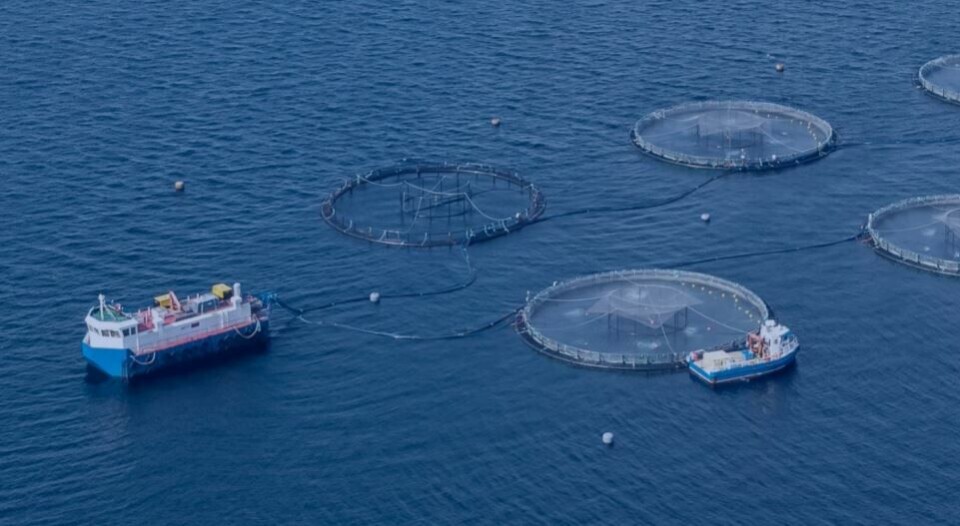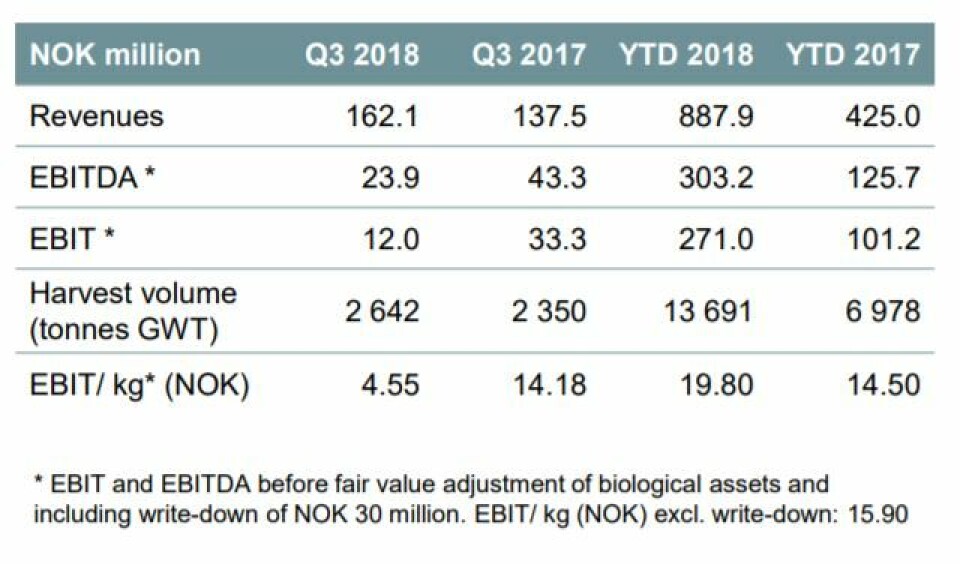
Grieg confident of Shetland growth despite setbacks
Grieg Seafood has announced a 14% drop in operating income for the third quarter of 2018, compared to the same period last year, although net profit was up from NOK190 million to NOK225m.
The Norwegian company’s total operating income amounted to NOK1.589 billion (Q3 2017: NOK1.855bn). The harvest of 16,941 tonnes was similar to Q3 2017 (16,875) but the price of NOK54.07 per kg was NOK1.74 per kg lower than in that period.
Farming costs also increased by NOK1.11 per kg compared to Q3 2017.
The company expects to harvest 24,100 tonnes in the final quarter of this year, making a total of 75,000 tonnes for the whole of 2018. It plans to increase its harvest to 82,000 tonnes next year and 100,000 tonnes in 2020.

Gill issues in Shetland
Grieg Seafood Shetland harvested 4,511 tonnes in Q3, a slight increase on the 4,391 tonnes harvested in Q3 2017, and sales revenue amounted to NOK274.9 million (Q3 2017: NOK265.9m).
But gill-related diseases in combination with sea lice treatments reduced the survival rate and increased the cost during the quarter. As a result, the Shetland took a write-down of NOK 19m towards the end of Q3, affecting the EBIT by NOK 4.21/kg, which meant a loss of NOK1.21/kg.
In its Q3 2018 report, Grieg pointed out that the industry in Shetland has over time endured biological challenges, and that production is focused on the best sites with the strongest possible biological control.
Aeration sytems
Routines and systems, similar to those applied at Grieg’s sites in British Columbia (BC), have been implemented for the monitoring of algae and oxygen levels. Other prioritised measures to ensure strong biosecurity, improved fish welfare and control of the sea lice situation include the use of aeration systems, fresh water treatments, sea lice skirts and cleaner fish.
The report added: “The root cause of the gill-related diseases is being investigated and the fish at sea are continuously being monitored to enable the rapid implementation of counter-measures.
“The underlying production in Shetland is as expected, but the production cost will remain high. The estimated harvest volume for the full year 2018 remains unchanged at 12 000 tonnes. The current challenges related to gill diseases and reduced survival are not expected to affect the region’s 2020 ambitions. Grieg Seafood Shetland targets a harvest volume of 17,000 tonnes with a production cost of NOK 43/kg in 2020.”
Five million smolts will have been set out by the end of the year.

Battling the blooms
In BC, Grieg harvested 2,642 tonnes (Q3 2017: 2,350) and sales revenue totalled NOK162.1m (Q3 2017: NOK137.5m), but as in Shetland costs took a chunk out of earnings. EBIT/kg was NOK4.55, down from 14.17 per kg in Q3 2017.
“During the quarter, Grieg Seafood BC experienced recurring incidents of harmful algal bloom (HAB) in one operating area, resulting in reduced survival and higher cost. A write-down of NOK30 million was recognised in Q3, affecting the EBIT by NOK11.36/kg,” stated Grieg.
It added: “As a result of the region’s strong algae preparedness, the current algae situation has been stabilised. The algae blooms have not had a material effect on the harvest plan and total harvest is still expected at 17,500 tonnes for 2018. However, lower quality and downgrading will affect the results also in the fourth quarter.
“The HAB incidents during the year has not impacted the region’s 2020 ambitions. Grieg Seafood BC will continue to grow harvest volumes and reduce costs, targeting a harvest volume of 20,000 tonnes with production cost of NOK 39/kg in 2020.”
More smolts
As part of the region’s smolt strategy, a decision was made in Q3 to expand the Golden River facility and increase production by 400 tonnes. The investment is estimated to be NOK50 million, and the expansion is expected to take full effect in 2020, at which time the region will be self-sufficient in terms of smolt deliveries.
Grieg’s best performance was in the Finnmark region of Norway, where 8,384 tonnes were harvested at EBIT/kg of NOK20.82 (Q3 2017: NOK17.98).
The company harvested 1,403 tonnes (Q3 2017: 1,687 tonnes) in Rogaland in Norway, at EBIT/kg of NOK0.42 (Q3 2017: NOK7.37).
The majority of the volume harvested was pancreas disease-affected fish, with downgraded quality and low average weight, contributing to low price achievement.




















































